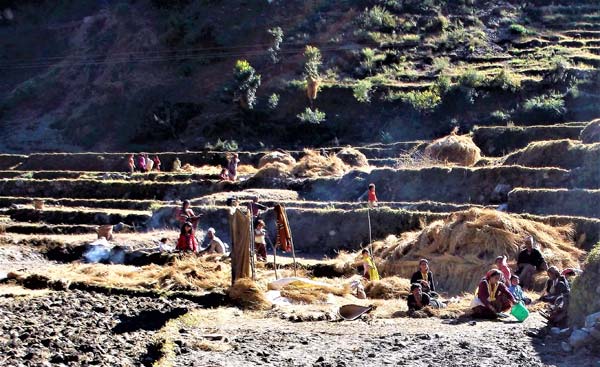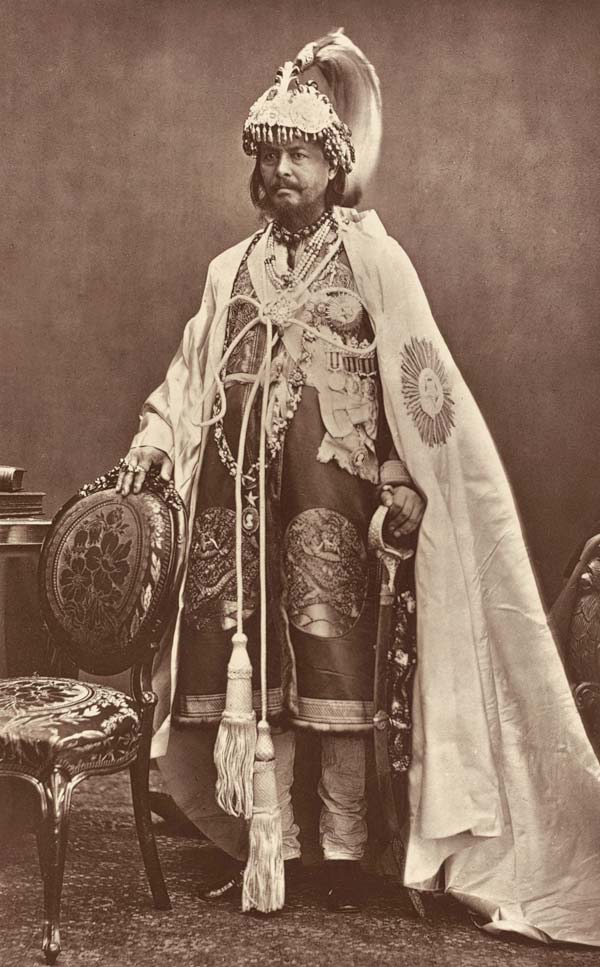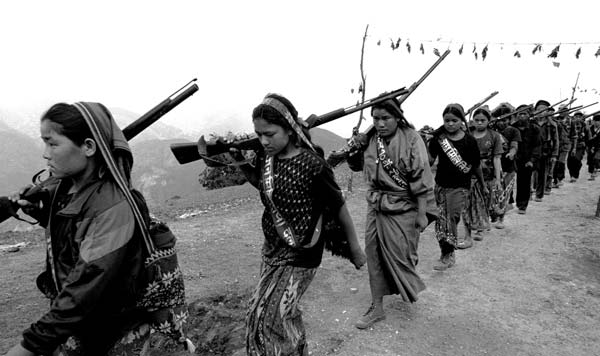Society
A NEPALESE STORY
The sample text below is an extract from a chapter in the fourth section in the book. For a full list of the book’s contents please see here.
Chapter 21:
A People’s War

An entire village decamps to the fields at harvest time. Historically, approximately 50% of the crop would be owed to the landowner for rent, usually in kind, leaving the other half for the villagers. But if weather or some other calamity compromised the harvest, the landowner still expected his usual amount of crop, leaving the peasantry with correspondingly less.
© Henry Edmundson
Given Nepal’s proximity to China, it was natural that communism would find a political voice in the lead-up to the Rana dynasty’s final years.
The Communist Party of Nepal (CPN) was founded in Calcutta in 1949, but on pressure from the Indian government banned by Nepal three years later. In 1954, the party’s first congress was held clandestinely in Patan, one of the Kathmandu Valley’s ancient capitals, resulting in the declared objective of replacing the monarchy with a republican constitution. The plan was to achieve this by holding elections for a Constituent Assembly, which in turn would work out the constitutional details. Their pipe dream ended a year later when King Tribhuvan passed away. His son Mahendra, of stronger mettle than his father, had no intention of compromising his position at the top of the Nepalese Government, for the sake of a handful of communists or anybody else.
He nevertheless removed the ban on the Communist Party in 1956, as a precautionary measure before wooing both the Soviet Union and China for aid. When Mahendra indulged in his brief experiment with parliamentary democracy in 1959, the CPN campaigned like any other political party, gaining 7.2% of the popular vote and four out of the 109 seats. Small fry compared with the landslide performance of the Nepali Congress Party, but nonetheless a decent showing for a party with little history and poor representation outside the capital. A year later, however, Mahendra tired of his democratic experiment and promptly banned all political parties, the CPN included.
During the next decades of Panchayat rule, the ban on political activity fostered a simmering discontent that swelled the ranks of activists right across the political spectrum. The CPN was no exception. However, Nepalese communists were in a quandary. They were struggling to accommodate the philosophical split between Khrushchev and Mao that occurred soon after Stalin’s death. The followers of the Marxist-Leninist program, inspired by Khrushchev and his disavowal of Stalin, sought to achieve a Nepalese republic by working legally within a democratic framework. The Maoists on the other hand were committed to violent confrontation, aping the Great Leader’s exhortation for continuous class struggle, particularly as they saw evidenced by the Cultural Revolution. The former, moderate group called themselves the Communist Party of Nepal (Marxist-Leninist), CPN (M-L) for short. The Maoists, when they finally united under one banner — a process that took almost twenty years — became known as CPN (Maoist).

Before the first road linking Nepal with India was built in 1956, the few cars in use in Kathmandu — by the Ranas or royal family — had to be carried there on a bamboo framework supported by teams of up to 96 men. Photograph taken by the German-American photographer Volkmar Wentzel.
Volkmar K. Wentzel / National Geographic Creative.
To start with, these developments moved forward clandestinely. But in 1980, following increasing pressure among the general populace, the altogether more amenable King Birendra agreed to democratise in part the Panchayat system of government set up by his father Mahendra. As a result, political parties were allowed to function openly again. Ten years later, in 1991, Birendra was pressured into abandoning the Panchayat system altogether and subsequently called a general election. In the meantime, the CPN (M-L) had combined with another Communist party, the two renaming themselves CPN (United Marxist-Leninist) or UML for short; the evolution of Nepal’s communist parties is complex to say the least. In this first general election, the UML won 69 out of 205 seats, a fair showing — curiously, a poll at this time showed that 30% of the party still believed that the King was an incarnation of Vishnu.

Jung Bahadur Rana (1817-1877) founded a dynasty of Nepalese prime ministers that lasted from 1846 to 1951. Descended from one of Prithvi Narayan Shah’s generals, Jung Bahadur Rana staged a bloody coup to seize power and reduce the Nepalese royal family to closeted figureheads who did his and his family’s bidding.
Courtesy of Old Indian Photos.
Three years later in a second general election, the UML won 88 seats, enough for them to be asked to form a coalition government. For the non-Maoist faction, everything seemed to be moving in the right direction. Nepal’s parliamentary democracy appeared stable, and the UML had grown to be a major player. None of this assuaged the Maoists, however. On the contrary. In September 1995, the leaders of CPN (Maoist) approved a plan for a full-blown armed insurrection against the state and four months later they launched their first attack, on a police station in the Rolpa district in the Rapti zone.
The leaders of CPN (Maoist) were from the western hill country, mostly high-caste Brahmins but from impoverished families. Pushpa Kamal Dahal, later known by his nom de guerre Prachanda meaning ‘fierce’, was the acknowledged leader. Charismatic, a gifted orator, pragmatic by nature, he remained under cover during most of the ten-year insurgency. He had been elevated to his position by the older Mohan Baidya, known as Kiran, who had entered underground communist politics much earlier but recognized Prachanda’s superior leadership.
Then there was Baburam Bhattarai, the more public face of CPN (Maoist), an intellectual, steeped in Marxist theory, with a PhD from the Jawaharlal Nehru University in Delhi; his thesis was entitled The Nature of Underdevelopment and Regional Structure of Nepal: a Marxist Analysis. These three men had witnessed and lived to no small degree the depredations of the Nepalese peasantry and were deeply committed.
Rolpa was a natural choice for the Maoists’ initial foray. A heavily forested area, only 10% of the land was cultivatable, and the typically small plots of land hardly provided for much more than a subsistence living. Many seasonally migrated to India to earn extra income. Ethnically, the population was Magar, and an isolated subgroup of Magars at that.
In the early 1990s, access to Rolpa was tiresome: two days drive from Kathmandu to the district capital Libang and then a day or two’s trek to neighbouring hamlets. The area was neglected even by hill country standards, a factor that had attracted so much attention from US aid programs. Consequently, Rolpa became a draw for aspiring Maoists in their attempts to woo the locals for a class struggle.
In April 1992, during district elections, Rolpa received a visit from Prime Minister Girija Prasad Koirala, the youngest of the Koirala brothers and the same who had helped stage the jute strike in Biratnagar all those years ago. He was now the bearer of the Nepali Congress Party mantle and had been asked to form a government when the previous UML coalition collapsed. Koirala arrived in Libang for a rally, but was heckled to a standstill by a crowd of several hundred Maoist sympathisers. As he retreated, brawls broke out between rival groups.
By degrees, Rolpa had become the place to be for aspiring combatants eager for training in guerrilla warfare and indoctrination in Maoist thought. But their growing numbers and creed of violence created tension in the community at large.

Three key players during the ouster of the Ranas — from left, B.P. Koirala, King Tribhuvan (wearing white Nepali Topi), and Jawaharlal Nehru (with flower garland). Months later, Tribhuvan returned to form a government and the beginnings of a constitutional monarchy.
Courtesy of Johannes Bornmann.
In October 1995, during a religious festival in a Rolpa village, the Maoist cadre staged a provocative, revolutionary song and dance session. Violence immediately erupted, resulting in injuries to more than one hundred and fifty people, most of them belonging to the Nepali Congress Party. Reprisals were swift. The government dispatched more than two thousand policemen to restore order, and, according to general reports, they ransacked houses and engaged in indiscriminate beatings, torture and rape. Violence on the part of the authorities at this scale was unheard of and shocking. Thousands of Magars from Rolpa and Rukum, a district to the north, fled from the area, many joining the Maoist cause once they dared return home.
By 1996, the movement had gained critical mass. At a gathering of more than 10,000 sympathisers in Libang, Prachanda announced that the time had come to launch a ‘class struggle’. Concurrently in Kathmandu, Baburam Bhattarai was making it official.
On February 4, he presented a letter to the prime minister’s office, outlining forty Maoist demands that in summary aimed to transform Nepal into a republic, confiscate land from feudal landlords, end privileges for the monarchy, and settle a score of other issues. The ultimatum ended: “We would like to inform you that if the government gives no positive indications towards this by February 17, we will be forced to adopt the path of armed struggle against the existing state power”. Viewing the Maoists as a petty annoyance in the western hills, the government didn’t even bother responding. The ‘People’s War’ was about to begin.
Early attacks on police stations were aimed at stealing weapons and equipment, and not taking life. Prachanda believed this would spread a message that they were seeking change and not violence for its own sake. And they certainly needed weapons. For the first attack, thirty-six Maoists could boast just one rather rusty, but functioning rifle acquired from Tibetan Khampa rebels, who appear in ‘Controlling the Margins’. In subsequent attacks, the Maoists also targeted landlord loan records, burning them to win round indebted peasants to the cause. But, inevitably, violence escalated on both sides. And as the rebels became better armed, the attacks got larger and bolder.

A brigade of women march in the hills of western Nepal carrying old muskets. The Maoists recruited the dispossessed from the poorest areas of Nepal: the indebted, the untouchables and women. Sourcing arms was a major challenge. The insurgents used whatever they could lay their hands on, later acquiring weapons captured during engagements with the government forces. Their weaponry would remain a perennial weakness.
Seamus Murphy / Panos.
By 2000, the Maoists were beginning to roam the countryside without hindrance, causing the authorities to retreat. Soon only eight of the original thirty-nine police stations in Rolpa remained manned, and a similar situation existed in the Rukum district. The government was beginning to lose control outside the capital, and not just in the western hills. The insurgency was also making gains in the east.
In September 2000, a particularly violent attack took place at Dunai, a district capital in the remote north-western Dolpo region and the first such district capital to be targeted. Almost 600 Maoist guerrillas departed their base in the Rukum district and over several days trekked over the 4,523-metre high Jang La northwards to where Dunai was situated. They were spotted by the authorities, and a forty-eight-strong police contingent was promptly flown into Dunai as reinforcement using a nearby airstrip. Nevertheless, the Maoists prevailed. In a ferocious attack lasting six hours, they killed fourteen policemen and took control of the police station, local government offices and jail. They also forced the local bank to open its vaults and walked off with the equivalent of fifty million Nepali rupees in cash, gold and silver. The following morning, they withdrew, carrying their wounded colleagues, and dispersed into the countryside ….
[BUY THE BOOK TO READ ON]
